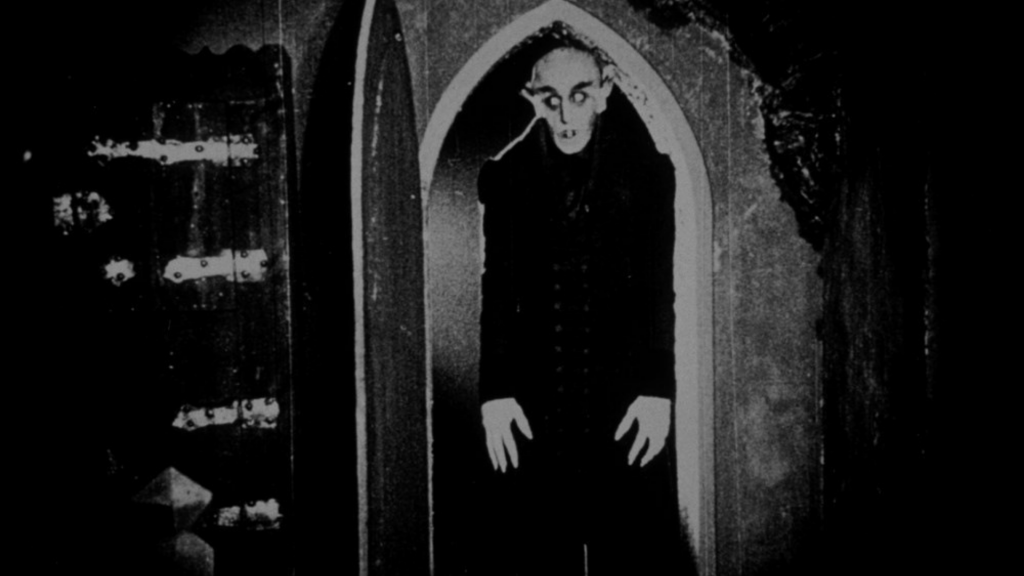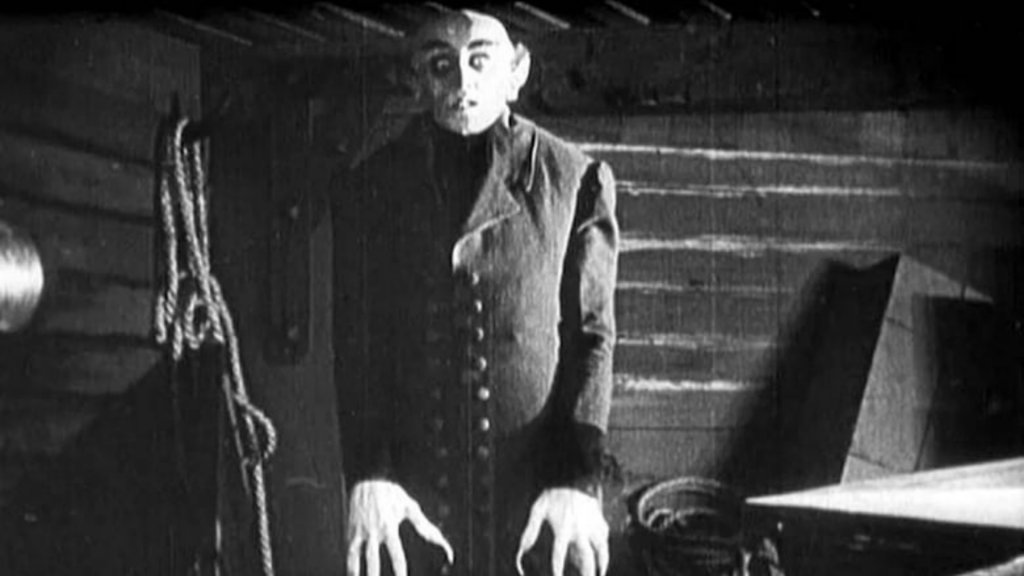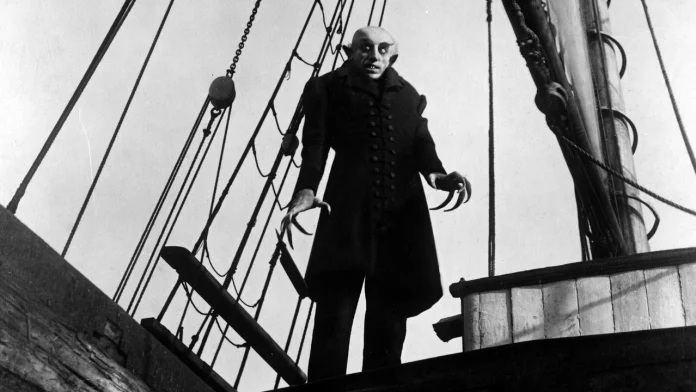2022 marks the 100th anniversary of one of the most important films ever made; German Expressionist director F.W Murnau’s 1922 horror masterpiece Nosferatu: A Symphony of Horror (often simply called Nosferatu). It is a century ago to the day that the film, often lauded as one of the best and most influential films of all time, had its German premiere at Berlin’s Primus-Palast.
Nosferatu is an unauthorised adaptation of Bram Stoker’s gothic novel Dracula. While it isn’t quite the first ever on-screen adaptation of Dracula nor the first vampire film, it is the earliest Dracula film that still exists (in this case Max Schreck’s Count Orlok acting as a Dracula stand-in). Murnau’s film is also one of the best examples of German Expressionism, a style of filmmaking influenced by the art movement of the same name that peaked in post-war Germany during the 1920s. The Cabinet of Doctor Caligari (1920), Metropolis (1927) and The Man Who Laughs (1928) are all famous examples of expressionism, but Nosferatu is arguably, where the movement reached its peak. As it predates films with synchronised sound, Nosferatu relies heavily on visuals to create the eerie gothic atmosphere described in Stoker’s original novel. The legendary Fritz Arno Wagner, one of the most influential cinematographers in film history and a pioneer of the visual portrayal of horror, does an excellent job. The iconic scenes of Orlock’s shadow creeping up the stairs, barely fitting in a door frame, or the Count slowly rising from a coffin, are all captured beautifully by Wagner and have cemented themselves as the backbone of cinematic horror. Wagner was essential in the German Expressionist movement. His use of lighting and shadows creates an eerie feeling to films like Nosferatu and they are on full display here.

German expressionist horror is not scary in the same way modern horror films are. The fear in silent films of the 1920s is atmospheric and stylistic. It was typical of German expressionist cinema to capitalise on the feelings of social hysteria and fear in post-war Germany, and the panic in Wisborg after Orlock’s arrival plays into this. The way that German Expressionist filmmakers took inspiration from the expressionist art movement is also clear to see in Nosferatu; the Scream by Herman Munch is in part the inspiration for Count Orlock’s appearance. The elongated face, hooked nose, spiked ears, and long fingers all add weight to Orlock’s legacy as an icon of horror. Orlock’s appearance is also a huge deviation from Dracula. Dracula is a suave, gentlemanly man who charms his way to his victims whereas Orlock is vicious and animalistic. We see rats fleeing Orlock’s coffins, and his appearance has often been compared to that of a rodent. He seems like a grotesque, inhuman creature rather than a man like future adaptations of Stoker’s vampire.
Nosferatu contributed much to horror culture, specifically vampires. In Bram Stoker’s original novel, sunlight weakened vampires, but it was Murnau’s creation of sunlight being deadly to them that solidified itself in the public conscience and still shows up in vampire media today. The entire style of 1920s German Expressionism in horror, which is at its peak here, is the blueprint for the horror genre in general. Figures hiding in the shadows, the slow eerie movement, the drastic use of lighting and darkness, all are now staples in horror, and staples in cinema in general and they were pioneered in films like Nosferatu.
Nosferatu and Murnau’s influence isn’t limited to horror either. Its impact can be found not just in the general vastness of cinema, but it the works of specific directors. The melodramatic style and dramatic shadows found in Tim Burton’s work is very evocative of Nosferatu. Even in Batman Returns (1992), one of the characters is called Max Shrek, named after the actor who brought Orlock to life. Indeed, the entire mythos of Batman is heavily inspired by Expressionism. Burton also included a nod to Nosferatu’s shadow effect in his deeply personal family movie Frankenweenie (2012). A remake of Murnau’s is currently in the works with director Robert Eggers at the helm, whose previous film The Lighthouse is a modern take on the type of German Expressionist cinema that Nosferatu perfected.

Despite its importance (although it couldn’t have been known at the time) and success, the Stoker estate were of the view that the changes Murnau made to the original Dracula novel were not enough to avoid copyright laws. As such, they successfully sued for copyright infringement. The studio behind Nosferatu, Prana Film, went bankrupt and were forced to destroy all copies of Murnau’s silent masterpiece. A film that has become so important was almost lost completely and it is difficult to emphasise how potentially different the landscape of cinematic horror would be today if they were successful in snuffing out every print of the film. However, much like Count Orlock, Nosferatu rose from the dead. Several unauthorised copies of the film survived, and it quickly became regarded as a masterpiece over the last century.
Nosferatu’s influence on cinema cannot be overstated. It is the ground-zero of cinematic horror and after 100 years it is still revered by critics and fans alike. Being technologically limited, it could not rely on sound to scare audiences, thus it defined the visual approach to creating terror in audiences that still endures a century later.
Words by Lewis Royle
Support The Indiependent
We’re trying to raise £200 a month to help cover our operational costs. This includes our ‘Writer of the Month’ awards, where we recognise the amazing work produced by our contributor team. If you’ve enjoyed reading our site, we’d really appreciate it if you could donate to The Indiependent. Whether you can give £1 or £10, you’d be making a huge difference to our small team.
